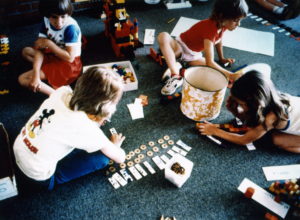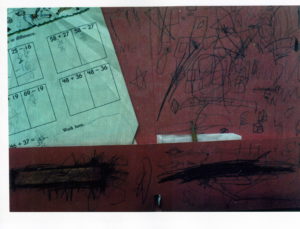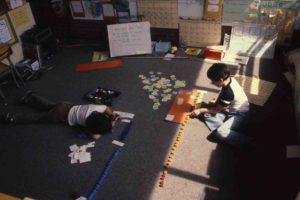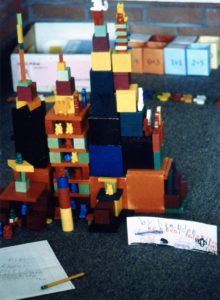
Yet we can distinguish between inarticulate genius and articulate idiocy – the first represented by the student who, by his operations and conclusions, reveal a deep grasp of a subject but not much ability to “say how it goes,” in contrast to the student who is full of seemingly appropriate words but has no matching ability to use the ideas for which the words stand (Bruner, p. 55).
Personal success, however, looks different to most girls. Girls tend to attribute their successes more to external causes such as luck or the situation. A girl who did well, for example, might believe that the test was easy or that the teacher liked her. Because these perceived causes are not under her control, she doesn’t see her success as predictive of future success (Horgan, p.15).
The requirement that mathematics should make sense was apparently not a feature of students’ mathematical instruction (Secada, Fennema, and Adajian, p19).
Becoming a teacher of Math Methods
After Apex ended, and following my tenure as Department Chair, I came back to the elementary faculty. I’ve always thought the phrase “back to the faculty” curious. I’d concluded in my last year as Chair that I could accomplish far more innovation as a faculty member in a small, dedicated program than I could as Chair of a department housing several programs. At this point in our College governance, Chairs had about as much influence as program coordinators, at least that was my perception of my power. Influence flowed generally upwards. Undergraduate programs in teacher education were the cash cow of the University and systems seemed to operate to create the biggest revenue for income flow from programs with the least expenditure of dollars. Anyway, I saw my return to the faculty as another opportunity to move ahead in my career. And the most exciting venture open to me was to join the junior year inquiry block in the “regular” eled program as a teacher of mathematics methods. I was anxious (looking forward to) to apply some of my learning about math education that began with my teaching at Madison Jr. High, and my work with manipulatives, mathematical patterning, and observing children’s math thinking that occurred during the Apex years.
Spending time watching our students work with children and mathematics in our professional field sites led me to believe our students were weak in their knowledge of mathematical structures and how children learned mathematics. I’d believed Jerome Bruner when he asserted that any concept could be taught to any child in a way that did justice to the structure of the concept and the way  children learned. I’d been fascinated with interpolating the implications of Piagetian theory to the classroom, especially as Herbert Ginsberg and Constance Kami considered children’s work in mathematics. The English Primary Revolution had evidenced rich learning opportunities with the Nuffield programs and Math Labs. There were all kinds of manipulative tools available to make the abstractions of math real for children, some of the best being Cuisenaire rods, attribute blocks, pattern blocks, geoboards, and unifix cubes. Historically, this intersection of children’s developmental readiness and math content was anything but new. I’d traced the intersection of material and mind all the way back to Comenius (1592-1670) who was the first educator to be known for his intentional use of pictures as a teaching tool.
children learned. I’d been fascinated with interpolating the implications of Piagetian theory to the classroom, especially as Herbert Ginsberg and Constance Kami considered children’s work in mathematics. The English Primary Revolution had evidenced rich learning opportunities with the Nuffield programs and Math Labs. There were all kinds of manipulative tools available to make the abstractions of math real for children, some of the best being Cuisenaire rods, attribute blocks, pattern blocks, geoboards, and unifix cubes. Historically, this intersection of children’s developmental readiness and math content was anything but new. I’d traced the intersection of material and mind all the way back to Comenius (1592-1670) who was the first educator to be known for his intentional use of pictures as a teaching tool.
My move into the curriculum block coincided with Vermont’s requiring fourth graders in Vermont to show what they knew and could do with mathematics through assessment of a demonstration portfolio. Using open-ended, uncertain problems, children had to demonstrate and describe their solution paths in writing. Qualitative analyses of their problem solving capability allowed teachers, families, and the children themselves to literally see their mathematics thinking as they worked their way through complicated problems. It was a very good time to be working in the area of math, because as a teacher you were required to (1) observe how children learned and thought about the world using a math mind and (2) provision instruction that met those two criteria.
When the concrete is abstract…manipulative mania
Early in my tenure in this role, I noticed my university students had a difficult time using manipulatives with children. It was as if in their minds, there was only one way to know something: abstractly. For many of them, something as simple as representing place value using c-rods or unifix cubes was difficult. They could regroup abstractly forever; the challenge came when they were asked to represent those ideas with real objects. I began to see this issue as an assessment issue. The questions that became mantra for me were all questions that focused on the intersections of content knowledge, learning styles (I do not like the ideal of “learning styles” but I’m using it here because it communicates that children learn math in very different ways), instructional method, and forms of assessment.
- How does a child know something?
- Do they know the concept concretely (using blocks), representationally (using drawings), or abstractly (with numbers)? (This by the way is my CAR approach to designing curriculum – Concrete, Abstract, and Representational forms of “proof”.
- Can they represent a given concept in several different ways? In combinations of ways?
- How does this child know place value (for example)?
- What questions can you ask and what materials can you provide that will serve as hurdle-help for this person to show you her thinking?
What was happening here for my undergrads were the tools caused content previously believed to be “simple” was actually far more complex than previously considered. For these old adolescents, college learners with powerful abstract cognitive systems, simple concrete constructions of mathematical processes and outcomes actually became abstract to them and difficult to render. If this sounds vaguely familiar, it should. In essence, we are talking about trying to organize “just right” mismatched instructional environments. Read what Diane writes about the shifts that occurred in her thinking as a result of this course.
(In school) I only memorized computation skill. I was not provided with activities to stimulate metacognitive thinking; therefore, there are very few mathematic concepts between my ears. Through the use of manipulatives and real-life problem solving, teachers can give students (a) something to think about in short term memory; (b) the ability to see relationships among the manipulatives, the problem, and previous knowledge that gets pulled out of long term memory, and (c) help them to organize their revision process around the manipulative tools, so that children become more deeply knowledgeable about their math. When children are introduced to concepts without previous construction of the necessary prerequisite skills, that information remains in state of “non-fit.” It will not become assimilated, therefore cannot be revised and reorganized. It will not make sense. It will not be conceptually learned (D. Trombley, 3/17/92).
When I read this now, I see echoes of Conceptual Systems Theory in Diane’s use of information processing theory, hands-on work with kids, and the formation of adequate conceptual structures as she explains how children should learn mathematics. I believe our children are safe with teachers who are equipped with understandings of the developmental process of learning, in this case, learning mathematics. This was fun work because teaching teachers to teach in this way was strengthening the connections Dewey talked about so eloquently. When teachers taught the way Diane wrote about, then instruction is as Dewey  proclaimed, “continuous reconstruction, moving from the child’s present experience into that represented by the organized bodies of truth we call studies.” If we were able to approximate this process all the time, we’d be teaching for connection continually. Assessment of children’s mathematical knowledge, assessments both statewide and national, showed just how badly we were missing the mark. Why, for instance, did males consistently outscore females on standardized tests of mathematical attainment? Why, for example, did the percentage of males dramatically exceed the percentage of females in mathematically related occupations? Why for example, did females consistently underperform in math and science. Clearly, other dynamics were at play.
proclaimed, “continuous reconstruction, moving from the child’s present experience into that represented by the organized bodies of truth we call studies.” If we were able to approximate this process all the time, we’d be teaching for connection continually. Assessment of children’s mathematical knowledge, assessments both statewide and national, showed just how badly we were missing the mark. Why, for instance, did males consistently outscore females on standardized tests of mathematical attainment? Why, for example, did the percentage of males dramatically exceed the percentage of females in mathematically related occupations? Why for example, did females consistently underperform in math and science. Clearly, other dynamics were at play.
Jo Sanders puts it on the table – girl discrimination
In 1997 and 1998, I attended two national trainings by Jo Sanders, a gender equity expert from the University of Washington, in my role as a funded Teacher Education Equity Fellow. As a result of yet another eye-opening experience in my life, I drafted an assignment for my math students that remains in the math methods course to this day even though I stopped teaching this course more than two decades ago. This assignment called upon my knowledge of Flanders’ Interaction Analysis, in form, if not content. Going into this seminar I knew there were ways you could “freeze” the process of instruction over a period of classroom minutes. I knew there were ways you could show inequitable instructional settings in classrooms; in fact, you could show different and inequitable instructional settings for groups of children in the same classroom! I came away from these seminars convinced that I wanted my students to record their lessons with learners in such a way as to determine if they were generating a classroom environment for boys during their teaching that was different than the environments they were generating for girls. The question was, “During a given lesson, do boys and girls experience different instruction? If so, what are the effects of these differential environments on their opportunity to learn, to reach your objectives?” Again, fun stuff. And very telling.
I adapted a system of verbal interaction analysis from Shepardson and Pizzini, two science educators. The idea was that my students would plan and teach a simple math lesson to a group of elementary school kids. The lesson would be video taped. They’d create a written transcript of the verbal interactions during the heart of the lesson, about twenty minutes worth. Then they’d code and analyze the transcript for males and females using the following categories of verbal interaction:
Praise (academic / non-academic),
Academic Criticism (intellectual quality of thinking / effort),
Nonacademic Criticism (mild / harsh),
Questions (low level / high level),
Academic Intervention (facilitates / short-circuits), and
Information Employed (academic / non-academic).
Prior research by the same two authors had established that academic praise, intellectual criticism, high level questions, and facilitating academic interventions defined instructional conditions of higher achievement. (I won’t go into the obvious parallels with Flanders’ research here but there are many.) What I wanted my students to determine was whether or not they were radiating equivalent instructional conditions for both males and females in their classroom groups.
Ahhh, the enemy is me
This was absolutely fascinating work. Many undergraduates believed, of course, that it was other teachers who evidenced conditions of inequity in their teaching. Certainly not them. After all, they knew all about this equity stuff and they weren’t going to fall into the trap of privileging one group of students over  another. I keep it to myself, but I call this assignment my Walt Kelly “Pogo Assignment.” Pogo was a cartoon character from somewhere in my not-too-recent past who was fond of saying, “We have met the enemy and he is us!” Well, for my students, after doing this analysis, most of them encountered themselves as Pogo’s enemy. Their data showed them that girls and boys experienced remarkably different instructional settings in their lesson and the data gave them fairly sophisticated ways of thinking about what they might do next. Sharon’s analysis if quite typical.
another. I keep it to myself, but I call this assignment my Walt Kelly “Pogo Assignment.” Pogo was a cartoon character from somewhere in my not-too-recent past who was fond of saying, “We have met the enemy and he is us!” Well, for my students, after doing this analysis, most of them encountered themselves as Pogo’s enemy. Their data showed them that girls and boys experienced remarkably different instructional settings in their lesson and the data gave them fairly sophisticated ways of thinking about what they might do next. Sharon’s analysis if quite typical.
In looking towards my next equity lesson, I believe that there are a few areas that I need to pay closer attention to. The first being, which groups I work with. I spent a lot of time working with the girls during this math lesson, assisting them when I probably should have given them more of a chance to work out the answers for themselves. I would do this in the future by allowing students to ask me questions, rather than “jump in” right away and assume they need help. I also need to pay more attention to the types of behaviors I allow during the lesson and those I do not. In this lesson the majority of Non-Academic Criticism comments were directed towards the boys’ behavior rather than the girls’ when the girls were being just as disruptive. Perhaps if I set some guidelines for behavior and tell the students what I expect from them, there will be less disciplinary problems that occur. …Perhaps if I had seemed more appreciative or more impressed with their work, there would have been less Non-Academic Criticism directed at the students, especially the boys.
Nailing down the locus of inequitable instruction
Before this assignment, Sharon didn’t even know you could analyze instruction much less use than use data-based analysis to guide yourself towards generating more equitable teaching styles. Sharon, and all her classmates, now had language to use to talk specifically about her own research-based equitable practice. She could point to where her verbal instruction was creating gender biased outcomes.
I find it interesting that these verbal categories of analysis all help articulate a kind of verbal climate in a classroom, a verbal climate that defines a particular kind of relationship between teacher and student during instruction. The same kind of analysis could be done for different groupings of students, groupings other than sex. Groupings defined by pigmentation, for instance, or economic difference, to use another example. Through the good work of Kathy Johnson and others, Vermont has graphic statewide data that show inequities in achievement based on race, gender, economic condition, and other “risk factors.”
This interaction analysis project is one way to examine how teachers use their power in the classroom to either empower or disempower their students. My math students learned, quite dramatically, the counterintuitive truth that they themselves were part of the problem. I don’t harbor illusions that once accomplished, my students henceforth practiced equitably. Equitable teaching is not a discrete actuality to be attained once and for all. This kind of teaching, teaching that connects deeply and in a liberating fashion to children in your classroom, is a constant process of refinement that shifts and fades and reasserts itself with each new group of individuals who walk in the classroom door. I do believe that as a result of this work on how children learn, and learn math in particular, how children can show what they know, and how different groups of children can experience radically inequitable instructional environments during the same lesson, my students will never return to a state of total ignorance with respect to their complicity in minimizing certain groups of children’s (girls, children from poverty backgrounds, children of color for example) opportunities to learn.

